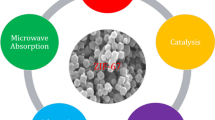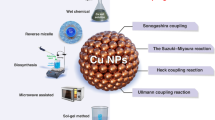Abstract
Three different formate-based metal–organic frameworks, [Zn(HCOO) 2 (Bip)], [H 2 N(CH 3 ) 2 ][Zn(HCOO) 3 ] and [Zn 2 (HCOO) 4 (H 2 O) 4 ], were obtained under solvothermal conditions in DMF. [Zn(HCOO) 2 (Bip)] is based on two ligands (formate and 4,4'-bipyridine), while [H 2 N(CH 3 ) 2 ][Zn(HCOO) 3 ] and [Zn 2 (HCOO) 4 (H 2 O) 4 ] only contain the formate ligand. The structural characterization of these compounds shows specific features for each of these networks. Importantly, the work presented herein proves that the formate is a result of DMF decomposition under the acidic solvothermal conditions used, a very relevant point that should be considered when planning solvothermal synthesis of MOFs with organic acids, such as azelaic acid.
Graphical Abstract
Three different formate-based metal–organic frameworks were obtained under solvothermal conditions in DMF. Structural characterization of these compounds shows specific features for each of these networks. The formate is a result of DMF decomposition under the acidic solvothermal conditions used.














Similar content being viewed by others
References
Janiak C, Vieth JK (2010) MOFs, MILs and more: concepts, properties and applications for porous coordination networks (PCNs). New J Chem 34(11):2366–2388
Notash B, Safari N, Khavasi HR (2012) Anion-controlled structural motif in one-dimensional coordination networks via cooperative weak noncovalent interactions. CrystEngComm 14(20):6788–6796
Keskin S, Kizilel S (2011) Biomedical applications of metal organic frameworks. Ind Eng Chem Res 50(4):1799–1812
Horcajada P, Gref R, Baati T, Allan PK, Maurin G, Couvreur P, Ferey G, Morris RE, Serre C (2012) Metal-organic frameworks in biomedicine. Chem Rev 112(2):1232–1268
Ferey G, Serre C (2009) Large breathing effects in three-dimensional porous hybrid matter: facts, analyses, rules and consequences. Chem Soc Rev 38(5):1380–1399
Xiao B, Wheatley PS, Zhao X, Fletcher AJ, Fox S, Rossi AG, Megson IL, Bordiga S, Regli L, Thomas KM et al (2007) High-capacity hydrogen and nitric oxide adsorption and storage in a metal-organic framework. J Am Chem Soc 129(5):1203–1209
Graetz J (2009) New approaches to hydrogen storage. Chem Soc Rev 38(1):73–82
Mueller M, Zhang X, Wang Y, Fischer RA (2009) Nanometer-sized titania hosted inside MOF-5. Chem Commun 1:119–121
Suh MP, Cheon YE, Lee EY (2008) Syntheses and functions of porous metallosupramolecular networks. Coord Chem Rev 252(8–9):1007–1026
Han SS, Mendoza-Cortes JL, Goddard WA (2009) Recent advances on simulation and theory of hydrogen storage in metal-organic frameworks and covalent organic frameworks. Chem Soc Rev 38(5):1460–1476
Dueren T, Bae Y-S, Snurr RQ (2009) Using molecular simulation to characterise metal-organic frameworks for adsorption applications. Chem Soc Rev 38(5):1237–1247
Ma S, Sun D, Ambrogio M, Fillinger JA, Parkin S, Zhou H-C (2007) Framework-catenation isomerism in metal-organic frameworks and its impact on hydrogen uptake. J Am Chem Soc 129(7):1858–1859
Uemura T, Ono Y, Kitagawa K, Kitagawa S (2008) Radical polymerization of vinyl monomers in porous coordination polymers: nanochannel size effects on reactivity, molecular weight, and stereostructure. Macromolecules 41(1):87–94
Uemura T, Yanai N, Kitagawa S (2009) Polymerization reactions in porous coordination polymers. Chem Soc Rev 38(5):1228–1236
Farrusseng D, Aguado S, Pinel C (2009) Metal-organic frameworks: opportunities for catalysis. Angew Chem Int Ed 48(41):7502–7513
Lee J, Farha OK, Roberts J, Scheidt KA, Nguyen ST, Hupp JT (2009) Metal-organic framework materials as catalysts. Chem Soc Rev 38(5):1450–1459
Allendorf MD, Bauer CA, Bhakta RK, Houk RJT (2009) Luminescent metal-organic frameworks. Chem Soc Rev 38(5):1330–1352
Kurmoo M (2009) Magnetic metal-organic frameworks. Chem Soc Rev 38(5):1353–1379
Evans OR, Lin WB (2002) Crystal engineering of NLO materials based on metal-organic coordination networks. Acc Chem Res 35(7):511–522
Horcajada P, Serre C, Vallet-Regi M, Sebban M, Taulelle F, Ferey G (2006) Metal-organic frameworks as efficient materials for drug delivery. Angew Chem Int Ed 45(36):5974–5978
Horcajada P, Serre C, Maurin G, Ramsahye NA, Balas F, Vallet-Regi M, Sebban M, Taulelle F, Ferey G (2008) Flexible porous metal-organic frameworks for a controlled drug delivery. J Am Chem Soc 130(21):6774–6780
Ferey G (2008) Hybrid porous solids: past, present, future. Chem Soc Rev 37(1):191–214
Millange F, Guillou N, Walton RI, Greneche J-M, Margiolaki I, Fereya G (2008) Effect of the nature of the metal on the breathing steps in MOFs with dynamic frameworks. Chem Comm 39:4732–4734
Della Rocca J, Liu D, Lin W (2011) Nanoscale metal-organic frameworks for biomedical imaging and drug delivery. Acc Chem Res 44(10):957–968
Hebert R (2004) Therapeutically improved salts of azelaic acid. United States Patent
Liu RH, Smith MK, Basta SA, Farmer ER (2006) Azelaic acid in the treatment of papulopustular rosacea—a systematic review of randomized controlled trials. Arch Dermatol 142(8):1047–1052
Caspari WA (1928) Crystallography of the aliphatic dicarboxylic acids. J Chem Soc 1928:3235–3241
Housty J, Hospital M (1967) Structures des deux formes cristallines de l’acide azélaique COOH[CH2]7COOH. Acta Crystallogr 22:288
Bond AD, Edwards MR, Jones W (2001) Azelaic acid. Acta Crystallogr E 57:o143–o144
Thalladi VR, Nusse M, Boese R (2000) The melting point alternation in alpha, omega-alkanedicarboxylic acids. J Am Chem Soc 122(38):9227–9236
Thompson LJ, Voguri RS, Male L, Tremayne M (2011) The crystal structures and melting point properties of isonicotinamide cocrystals with alkanediacids HO2C(CH2)(n-2)CO2H n = 7-9. CrystEngComm 13(12):4188–4195
Edwards MR, Jones W, Motherwell WDS (2002) Influence of dicarboxylic acid structure on tape networks in co-crystals of 2-pyridone. Cryst Eng 5(1):25–36
Braga D, Maini L, de Sanctis G, Rubini K, Grepioni F, Chierotti MR, Gobetto R (2003) Mechanochemical preparation of hydrogen-bonded adducts between the diamine 1,4-diazabicyclo 2.2.2 octane and dicarboxylic acids of variable chain length: an x-ray diffraction and solid-state NMR study. Chem Eur J 9(22):5538–5548
Karki S, Friscic T, Jones W (2009) Control and interconversion of cocrystal stoichiometry in grinding: stepwise mechanism for the formation of a hydrogen-bonded cocrystal. CrystEngComm 11(3):470–481
Aakeroy CB, Hussain I, Desper J (2006) 2-Acetaminopyridine: a highly effective cocrystallizing agent. Cryst Growth Des 6(2):474–480
Lawniczak P, Pogorzelec-Glaser K, Pawlaczyk C, Pietraszko A, Szczesniak L (2009) New 2-methylimidazole-dicarboxylic acid molecular crystals: crystal structure and proton conductivity. J Phys Condens Matter 21(34):345403
Braga D, Dichiarante E, Palladino G, Grepioni F, Chierotti MR, Gobetto R, Pellegrino L (2010) Remarkable reversal of melting point alternation by co-crystallization. CrystEngComm 12(11):3534–3536
Aakeroy CB, Panikkattu SV, DeHaven B, Desper J (2012) Establishing supramolecular control over solid-state architectures: a simple mix and match strategy. Cryst Growth Des 12(5):2579–2587
Bruker AXS (2005) SADABS bruker analytical systems. Bruker AXS Inc., Madison
Altomare A, Burla MC, Camalli M, Cascarano GL, Giacovazzo C, Guagliardi A, Moliterni AGG, Polidori G, Spagna R (1999) SIR97: a new tool for crystal structure determination and refinement. J Appl Crystallogr 32:115–119
Sheldrick GM (2008) A short history of SHELX. Acta Crystallogr A 64:112–122
Farrugia LJ (1999) WinGX suite for small-molecule single-crystal crystallography. J Appl Cryst 32:837–838
Macrae CF, Bruno IJ, Chisholm JA, Edgington PR, McCabe P, Pidcock E, Rodriguez-Monge L, Taylor R, van de Streek J, Wood PA (2008) Mercury CSD 2.0—new features for the visualization and investigation of crystal structures. J Appl Crystallogr 41:466–470
Spek AL (2009) Structure validation in chemical crystallography. Acta Crystallogr D 65:148–155
Huh HS, Lee SW (2008) Unexpected formation of the cobalt-formate coordination polymer [Co3(HCO2)6].dmf from [Co(NO3)2 and 2,2′-bipyridine-5,5′-dicarboxylic acid in dmf-EtOH-H2O. Bull Korean Chem Soc 29(12):2383–2389
Min D, Lee SW (2002) Terbium-oxalate-pyridinedicarboxylate coordination polymers suggesting the reductive coupling of carbon dioxide (CO2) to oxolate (C2O4 2−): [Tb2 (3,5-PDC)2(H2O)4(C2O4)].2H2O and [Tb(2,4-PDC)(H2O)(C2O4)0.5] (PDC = pyridinedicarboxylate). Inorg Chem Commun. 5(11):978–983
Yan Y, Wu CD, Lu CZ (2003) Hydrothermal synthesis of two new transition metal coordination polymers with mixed ligands. Z Anorg Allg Chem 629(11):1991–1995
Huh HS, Lee SW (2006) Lanthanide-oxalate coordination polymers formed by reductive coupling of carbon dioxide to oxalate: [Ln2(3,5-pdc)2(C2O4)(H2O)4]·2H2O (Ln = Eu, Sm, Ho, Dy; pdc = pyridinedicarboxylate). Bull Korean Chem Soc 27(11):1839–1843
Acknowledgments
Authors acknowledge funding to Fundação para a Ciência e a Tecnologia (PTDC/CTM-BPC/122447/2010, PEST-OE/QUI/UI0100/2013, RECI/QEQ-QIN70189/2012 and SFRH/BPD/78854/2011).
Author information
Authors and Affiliations
Corresponding authors
Rights and permissions
About this article
Cite this article
Quaresma, S., André, V., Martins, M. et al. Zinc-Formate Metal–Organic Frameworks: Watch Out for Reactive Solvents. J Chem Crystallogr 45, 178–188 (2015). https://doi.org/10.1007/s10870-015-0578-y
Received:
Accepted:
Published:
Issue Date:
DOI: https://doi.org/10.1007/s10870-015-0578-y




